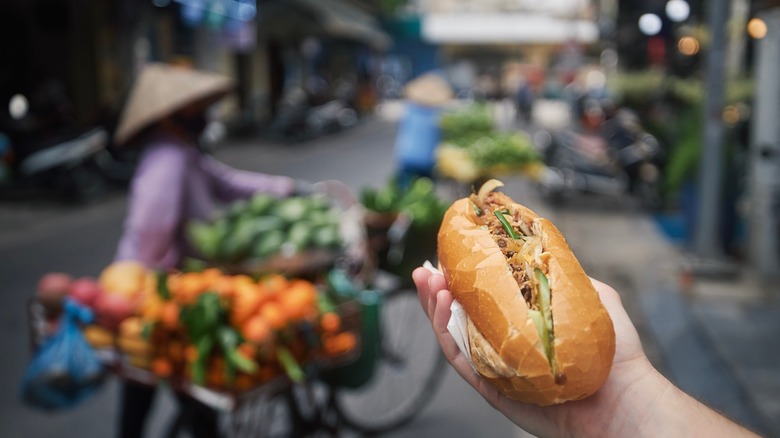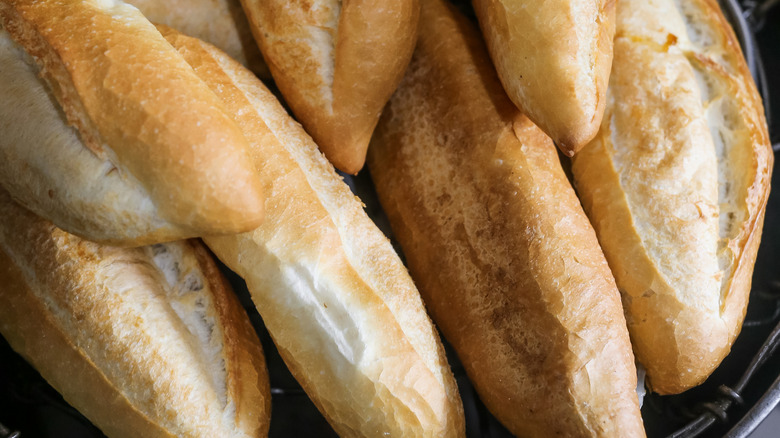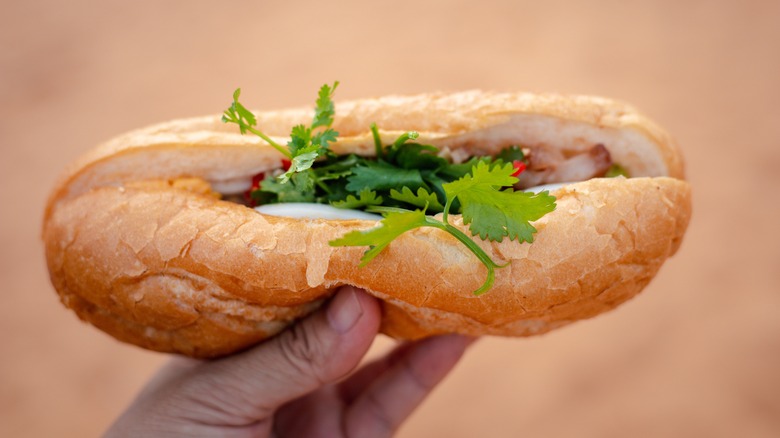The Only Bread You'll Ever Need For A Perfect Bánh Mì Sandwich
Vietnamese cuisine offers an impressive range of tasty delights. While many of its dishes have become favorites abroad, when it comes to casual dishes, it's hard to top the popularity of the bánh mì. This French-influenced sandwich is nearly always enjoyed as an affordable and delicious street food brimming with flavor. In addition to popular fillings like meatballs, pâté, and pork rolls, the dish can even come with red wine stew or as a dessert.
However, its dependable ingredient — and perhaps most essential component — is the bread. At first glance, it may look like a smaller version of the French baguette. Undeniably, it does bear a strong resemblance to the iconic European loaf, but the Vietnamese craft their version differently. The interior is much more airy, and the exterior is delectably crispy, but very thin. The bread's flaky and soft, which lets the fillings take center stage.
It all makes for the ideal sandwich vessel that contrasts both the proteins and vibrant toppings. Not to mention it comes in a smaller size than the French baguette, which further enables you to eat it on the go. The baked good's fundamental nature is even evinced in the name; bánh mì means "bread" in Vietnamese. So to craft your own version, you'll want to find (or make) this delicious loaf.
Bánh mì bread has an unique composition built for the sandwich
Several factors distinguish bánh mì bread's from a French-style baguette. Oftentimes, a rice flour base is mistakenly noted as the central distinguishing factor. Some bakers do employ rice flour alongside a higher protein flour, but it's not the standard across the board. Instead, it's the assembly method that really sets this style of loaf apart.
First, Vietnamese bakers mix their dough in a much more fast-paced and rigorous manner. Such briskness enhances the internal airiness. Next, the dough is proofed for a long time between 70 and 77 F. And the cooking process is finished in an extra hot oven, fueled by convection heat, and accompanied with a pan of water. The steam is a crucial agent for the best rise, while a spray of water during baking promotes a crispier crust.
Plus, the shape also is a distinguishing factor between the French baguette and the bánh mì bread. No one knows why French baguettes are so long, and Vietnamese bakers have reshaped the bread to make it a much more convenient street-side snack. In addition to less length, the bread also has a slightly smaller diameter. And to attain a perfect log shape, it must be rolled up with a specific motion. This makes every Vietnamese bánh mì loaf a perfect sandwich vessel.
Seek out Vietnamese bread for delicious bánh mìs
To achieve the perfect sandwich consistency, you'll need to put in the effort of tracking down the special baguette. A dedicated Vietnamese bakery is an excellent starting point. If you live in cities like Los Angeles, Houston, or San Jose, the large Vietnamese population may open up several options for tracking the loaves down. Alternatively, you can even opt for home delivery; shops like James Beard Award-winner Dong Phuong Bakery offer shipping across the country. Or, employ some of these key tips to finding ridiculously good Vietnamese restaurants, and inquire to see if they'll sell you a few loaves.
If you're feeling more ambitious — and have some baking experience — it's possible to undertake crafting your own, too. In addition to the aforementioned distinctions, the process comes with a few logistics that can be difficult to implement in a home kitchen. You'll need a finely-regulated proofing temperature, as well as an extra-humid oven. However, get those logistics in place, and you'll have the golden keys to making many perfect bánh mì loaves.
And if your bread hunt is still coming up short, consider whipping up a delicious riff like a bánh mì spiral cut hot dog or a bánh mì-inspired taco. There's lots of ways to encapsulate the delicious spirit of the sandwich using a different approach. But there's no denying there's a magical allure to the Vietnamese-style baguette.


